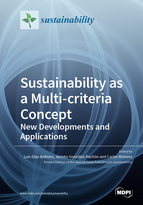Sustainability as a Multi-criteria Concept: New Developments and Applications
A special issue of Sustainability (ISSN 2071-1050). This special issue belongs to the section "Environmental Sustainability and Applications".
Deadline for manuscript submissions: closed (30 June 2020) | Viewed by 44870
Special Issue Editors
Interests: forest management; forest sustainability; multi-criteria decision-making techniques
Special Issues, Collections and Topics in MDPI journals
Interests: participatory decision-making; aggregation of preferences; negotiation; multi-criteria decision-making
Interests: multicriteria decision making and economics; environment sustainable management; forest management
Special Issues, Collections and Topics in MDPI journals
Special Issue Information
Dear Colleagues,
Sustainability is an old concept born in the 18th century in the field of forestry within a mono-functionality perspective. This concept has considerably evolved in the last few years towards a multi-functionality context with applications in practically all areas of economic interest. On the other hand, modern sustainability is a complex problem for two types of reasons: a) The multiplicity of functions of very different nature involved in the process and b) The manner in which different segments of the society or stakeholders perceive the relative importance of these functions.
Therefore, a realistic approach to dealing with sustainability issue requires taking into consideration multiple criteria of different nature (economic, environmental, and social), in many cases within a participatory decision-making framework. This Special Issue aims to encourage works in both theoretical and applied fields dealing with different issues of sustainability with the help of a modern multiple-criteria decision-making theory and a single or several stakeholders involved in the decision-making process.
Prof. Dr. Luis Diaz-Balteiro
Prof. Dr. Jacinto González-Pachón
Prof. Dr. Carlos Romero
Guest Editors
Manuscript Submission Information
Manuscripts should be submitted online at www.mdpi.com by registering and logging in to this website. Once you are registered, click here to go to the submission form. Manuscripts can be submitted until the deadline. All submissions that pass pre-check are peer-reviewed. Accepted papers will be published continuously in the journal (as soon as accepted) and will be listed together on the special issue website. Research articles, review articles as well as short communications are invited. For planned papers, a title and short abstract (about 100 words) can be sent to the Editorial Office for announcement on this website.
Submitted manuscripts should not have been published previously, nor be under consideration for publication elsewhere (except conference proceedings papers). All manuscripts are thoroughly refereed through a single-blind peer-review process. A guide for authors and other relevant information for submission of manuscripts is available on the Instructions for Authors page. Sustainability is an international peer-reviewed open access semimonthly journal published by MDPI.
Please visit the Instructions for Authors page before submitting a manuscript. The Article Processing Charge (APC) for publication in this open access journal is 2400 CHF (Swiss Francs). Submitted papers should be well formatted and use good English. Authors may use MDPI's English editing service prior to publication or during author revisions.
Keywords
- Multiple Criteria Decision Making
- Indicators and Synthetic Indices
- Sustainability Measurement.
- Rankings in terms of Sustainability
- Environmental and Natural Resources Economics
- Collective Decision Making








